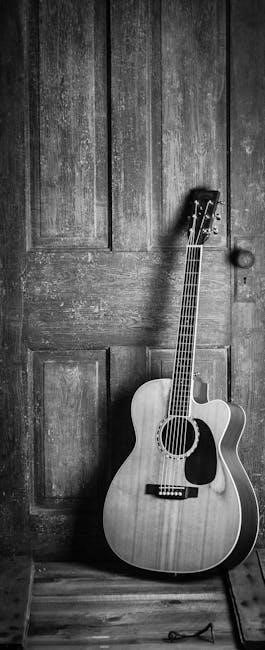guitar triads pdf

Guitar triads are three-note chords built from a root, third, and fifth, forming the foundation of harmony in music. They are essential for composition and improvisation, offering versatility across genres by breaking down complex chords into manageable shapes. Mastering triads enhances your understanding of the fretboard and music theory, making them a vital tool for guitarists at all skill levels.
What Are Guitar Triads?
Guitar triads are simple three-note chords constructed from a root, a third, and a fifth. They are the building blocks of harmony and music theory, providing a concise way to represent chords. Unlike full chords, triads focus on the essential tones, making them versatile and easier to play. They can be major, minor, diminished, or augmented, each conveying a distinct emotional quality. Triads are highly movable and can be played in various positions on the fretboard, offering flexibility for composition and improvisation. By mastering triads, guitarists gain a deeper understanding of chord structures and harmony, enabling them to create complex melodies and progressions with ease. Their simplicity makes them an invaluable tool for both beginners and advanced players looking to enhance their musical expression.
Importance of Triads in Guitar Playing
Guitar triads are fundamental to understanding harmony and music theory, serving as the backbone for chord progressions and compositions. They simplify complex chords into essential tones, making them easier to play and transpose across the fretboard. Triads are crucial for improvisation, as they provide a framework for creating melodies and solos. By mastering triads, guitarists can build stronger chord voicings and develop a deeper connection to the music they play. Their versatility allows them to be used in various genres, from rock to jazz, enhancing both rhythm and lead playing. Essentially, triads are the building blocks that bridge theory and practice, making them indispensable for players of all levels.
Types of Guitar Triads
Guitar triads include major, minor, diminished, and augmented triads. Each type is defined by specific intervals: major (root, major third, perfect fifth), minor (root, minor third, perfect fifth), diminished (root, minor third, diminished fifth), and augmented (root, major third, augmented fifth).

Major Triads
Major triads are the most common and harmonically pleasing triads in music. They consist of a root note, a major third (four semitones above the root), and a perfect fifth (seven semitones above the root). For example, a C major triad includes the notes C, E, and G. These triads are often used in chord progressions and melodies to create a bright, uplifting sound. Guitarists can play major triads in open positions or as movable shapes across the fretboard. Understanding and mastering major triads is fundamental for any guitarist, as they form the basis of more complex chords and harmonic structures. Regular practice helps in building finger strength and improving dexterity for smooth transitions between triads.
Minor Triads
Minor triads are three-note chords consisting of a root, minor third (three semitones above the root), and perfect fifth. For example, an A minor triad includes A, C, and E. These triads create a somber, melancholic sound, often used to convey emotion in music. Guitarists can play minor triads in open positions or as movable shapes across the fretboard. To form a minor triad, start with a major triad and lower the third by one semitone. Practicing minor triads enhances your ability to create rich, expressive melodies and chord progressions. They are essential for understanding minor keys and modes, making them a cornerstone of musical harmony. Regular practice helps in mastering their shapes and applications in various musical contexts.
Diminished and Augmented Triads

Diminished and augmented triads are specialized three-note chords that add unique textures to music. A diminished triad consists of a root, minor third, and diminished fifth, creating a tense, unstable sound. For example, a C diminished triad includes C, Eb, and Gb. Augmented triads, on the other hand, feature a root, major third, and augmented fifth, producing a bright, unsettling quality, as seen in a C augmented triad (C, E, G#). Both triads are less commonly used than major or minor triads but are powerful tools for adding emotional depth and complexity to compositions. Guitarists can use these triads to create chromatic passages or to add dissonance in improvisation. Understanding diminished and augmented triads expands your harmonic palette, enabling richer and more dynamic musical expression.

How to Play Guitar Triads
Start by learning open-position triads, focusing on clean tones and smooth transitions. Progress to movable shapes, using barre chords to play triads across the fretboard efficiently.
Open Position Triads
Open position triads are simple, versatile chords played on the lower frets without a barre. They consist of three notes: the root, third, and fifth. These triads are ideal for beginners, as they require minimal finger stretching and effort. Start with common open triads like G, C, and D, which are foundational for many songs. Play each note cleanly, ensuring clarity and proper finger placement. Open triads are great for practicing chord shapes and transitions, helping build finger strength and dexterity. They also serve as a starting point for creating melodies and harmonies. By mastering these shapes, you can easily expand to more complex chords and techniques. Open position triads are a essential tool for any guitarist looking to improve their skills and musical understanding.
Barre Chords and Movable Shapes
Barre chords and movable shapes are advanced techniques for playing triads across the fretboard. Unlike open position triads, barre chords require pressing a finger across multiple strings to create a movable chord shape. These shapes are versatile, as they can be slid up and down the neck to play the same chord in different keys. Start by learning the basic movable shapes for major and minor triads, focusing on proper finger placement and string muting. Practice transitioning between shapes smoothly to build finger strength and accuracy. Movable triads are essential for more complex music, allowing you to play chords in any key with precision. They also enable advanced techniques like chord melodies and intricate harmonies, making them a cornerstone of intermediate and advanced guitar playing.

Using Triads in Composition and Improvisation
Triads are fundamental in composition and improvisation, offering a harmonic foundation that sparks creativity. They can be used to craft melodies and add depth to musical layers.
Creating Melodies with Triads
Creating melodies with triads is an exciting way to add harmonic richness to your playing. By focusing on three-note shapes, you can craft memorable and engaging lines that stand out. Start by selecting a key and identifying the I, IV, and V triads, which form the harmonic backbone of many songs. Experiment with connecting these shapes across the fretboard, ensuring smooth transitions between notes. To enhance your melodies, try adding enclosures or chromatic passages around the triad tones, giving your lines a more polished feel. Practice playing these shapes in different positions and keys to build familiarity and versatility. Over time, this approach will help you develop a unique melodic style that incorporates the simplicity and power of triads.
Triads in Improvisation
Triads are a powerful tool for improvisation, offering a harmonic foundation that connects chords seamlessly. By focusing on the root, third, and fifth of a scale, you can create fluid, melodic lines that align with chord progressions. Jazz musicians often use triads to navigate complex changes, ensuring their solos sound cohesive and intentional. Start by practicing minor and major triads in various keys, paying attention to how they fit within chord structures. Experiment with chromatic passages or varied rhythms to add depth to your playing. Over time, this approach will enhance your ability to improvise with confidence and clarity, making triads an indispensable part of your musical toolkit.
Guitar triads are a fundamental yet versatile component of music, offering a gateway to advanced techniques and deeper musical understanding. Whether you’re composing, improvising, or exploring various genres, triads provide the harmonic foundation needed to enhance your playing. By mastering major, minor, and extended triads, you’ll unlock new possibilities for expression and creativity. Incorporate triads into your practice routine to build finger strength, improve fretboard navigation, and develop a richer musical vocabulary. With consistent practice, you’ll find triads becoming an essential tool in your guitar-playing journey, bridging the gap between theory and practical application.



Leave a Reply
You must be logged in to post a comment.